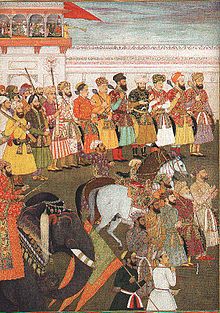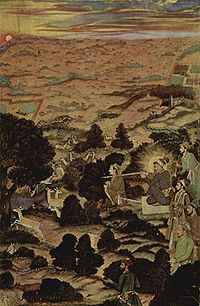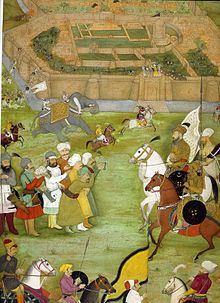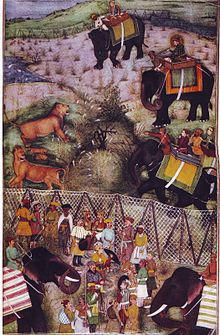- Shah Jahan
-
For other people named Shah Jahan, see Shah Jahan (disambiguation).
Shah Jahan 
"Shah Jahan on a globe" from the Smithsonian Institution  5th Mughal Emperor
5th Mughal EmperorReign 8 November 1627 - 2 August 1658
(30 years, 267 days)Coronation 25 January 1628, Agra Predecessor Jahangir Successor Aurangzeb Spouse Akbarabadi Mahal
Kandahari Mahal
Mumtaz MahalIssue Jahanara Begum
Dara Shikoh
Shah Shuja
Roshanara Begum
Aurangzeb
Murad Baksh
Gauhara BegumHouse Timurid Father Jahangir Mother Princess Manmati[1] Born 5 January 1592
Lahore, PakistanDied 22 January 1666 (aged 74)
AgraBurial Taj Mahal Religion Islam Shah Jahan (also spelled Shah Jehan, Shahjehan, Urdu: شاه جہاں, Persian: شاه جهان) (January 5, 1592 – January 22, 1666) (Full title: His Imperial Majesty Al-Sultan al-'Azam wal Khaqan al-Mukarram, Malik-ul-Sultanat, Ala Hazrat Abu'l-Muzaffar Shahab ud-din Muhammad Shah Jahan I, Sahib-i-Qiran-i-Sani, Padshah Ghazi Zillu'llah, Firdaus-Ashiyani, Shahanshah—E--Sultanant Ul Hindiya Wal Mughaliya, Emperor of India ) was the emperor of the Mughal Empire in the Indian Subcontinent from 1628 until 1658. The name Shah Jahan comes from Persian meaning "King of the World." He was the fifth Mughal emperor after Babur, Humayun, Akbar, and Jahangir. While young, he was favourite of his legendary grandfather Akbar the Great. He is also called Shahjahan the Magnificent. Besides being a descendant of Genghis Khan, Emperor of Mongol Empire and Tamerlane, he is also a descendant of Emperor Charlemagne, the King of the Franks, King of the Lombards and the Emperor of the Romans.[2][3]
Even while very young, he was chosen as successor to the Mughal throne after the death of Emperor Jahangir. He succeeded to the throne upon his father's death in 1627. He is considered to be one of the greatest Mughals and his reign has been called the Golden Age of the Mughals and one of the most prosperous ages of the Indian civilization. Like Akbar, he too was eager to expand his vast empire. In 1658 he fell ill, and was confined by his son Emperor Aurangzeb in the Citadel of Agra until his death in 1666. On the eve of his death in 1666, he was one of the most powerful personalities on the earth and his Mughal Empire spanned almost 750,000,000 acres (3,000,000 km2) and he had in his empire the largest and most prosperous capital as well as some of the most spectacular architectural masterpieces in the world.
The period of his reign was the golden age of Mughal architecture. Shahanshah Shah Jahan erected many splendid monuments, the most famous of which is the legendary Taj Mahal at Agra built as a tomb for his wife, Empress Mumtaz Mahal. The Pearl Mosque and many other buildings in Agra, the Red Fort and the Jama Masjid Mosque in Delhi, mosques in Lahore, extensions to Lahore Fort and a mosque in Thatta also commemorate him. The famous Takht-e-Taus or the Peacock Throne, said to be worth millions of dollars by modern estimates, also dates from his reign. He was also the founder of the new imperial capital called Shahjahanabad, now known as Old Delhi. Other important buildings of Shah Jahan's rule were the Diwan-i-Am and Diwan-i-Khas in the Red Fort Complex in Delhi and the Pearl Mosque in the Lahore Fort. It is pointed out that the Palace of Delhi is the most magnificent in the East. Shah Jahan is also believed to have the most refined of the tastes in arts and architecture and is credited to have commissioned about 777 gardens in Kashmir, his favourite summer residence. Surprisingly, a few of these gardens survive even till date and attracts thousands of tourists every year.[4]
Contents
Biography
Baadshah Shah Jahan was born as Prince Shihab-ud-din Muhammad Khurram, on January 5, 1592 in Lahore, Pakistan as the third and favorite son of the emperor Jahangir from his Rajput wife Gossaini.[5] The name Khurram - Persian for 'joyful' - was given by his grandfather Akbar.[6] His early years saw him receive a cultured, broad education and he distinguished himself in the martial arts and as a military commander while leading his father's armies in numerous campaigns - Mewar (1615 CE, 1024 AH), the Deccan (1617 and 1621 CE, 1026 and 1030 AH), Kangra (1618 CE, 1027AH). He was responsible for most of the territorial gains during his father's reign.[7] He also demonstrated a precocious talent for building, impressing his father at the age of 16 when he built his quarters within his great grandfather Emperor Babur's Kabul fort and redesigned buildings within Agra fort.[7] He also carries the universally famous titles like "The builder of marvels ".
Marriage
In 1607 CE (1025 AH), at the age of fifteen, Khurram married Arjumand Banu Begum, the grand daughter of a Persian noble, who was 14 years old at the time.She was also the niece of the famous queen of Jehangir-Nur Mahal After their wedding celebrations, Khurram "finding her in appearance and character elect among all the women of the time," gave her the title Mumtaz Mahal (Jewel of the Palace).[8]
Mumtaz Mahal had 14 children. Despite her frequent pregnancies, she travelled with Shah Jahan's entourage throughout his earlier military campaigns and the subsequent rebellion against his father. Mumtaz Mahal was utterly devoted — she was his constant companion and trusted confidante and their relationship was intense.[9] She is portrayed by Shah Jahan's chroniclers as the perfect wife with no aspirations to political power. This is in direct opposition to how Nur Jahan had been perceived.[9] She died an accidental death, while giving birth to her 14th child. When Shah Jahan travelled to Balapur fort, Burhanpur, mother of Mirza Azam and elder daughter of Shahzada Badi uz-Zaman Mirza, alias Shah Nawaz Khan of the Safawi dynasty Dilrus Banu, wife of Auranzeb along with Mumtaz and cousin/brother Shah Beg Khan, along with military personnel - stayed three nights near Argaon at Hiwarkhed, before the birth of their fourteenth child. Mumtaz died in Burhanpur in 1631 AD (1040 AH), while giving birth to their fourteenth child. She had been accompanying her husband while he was fighting a campaign in the Deccan Plateau. Her body was temporarily buried at Burhanpur in a walled pleasure garden known as Zainabad originally constructed by Shah Jahan's uncle Daniyal on the bank of the Tapti River..
The intervening years had seen Khurrum take two other wives known as Akbarabadi Mahal (d.1677 CE, 1088 AH), and Kandahari Mahal (b. c1594 CE, c1002 AH), (m.1609 CE, 1018 AH).
According to the official court chronicler Qazwini, the relationship with his other wives "had nothing more than the status of marriage. The intimacy, deep affection, attention and favor which His Majesty had for the Cradle of Excellence [Mumtaz Mahal] exceeded by a thousand times what he felt for any other."[8][10][11] Several European chroniclers suggested that Shah Jahan had an incestuous relationship with his daughter Jahanara Begum. The French traveller Francois Bernier wrote, "Begum Sahib, the elder daughter of Shah Jahan was very beautiful... but Lal pointed out that Aurangzeb may have been involved in "magnifying a rumour into a full-fledged scandal", and wrote: "Aurangzeb had disobeyed Shahjahan, he had incarcerated him for years, but if he really helped give a twist to Shahjahan's paternal love for Jahan Ara by turning it into a scandal, it was the unkindest cut of all his unfilial acts." But no authentic proof says that the great mughal had any such relationship.
Accession
Inheritance of power and wealth in the Mughal empire was not determined through primogeniture, but by princely sons competing to achieve military successes and consolidating their power at court. This often led to rebellions and wars of succession. As a result, a complex political climate surrounded the Mughal court in Shahzada Khurram's formative years. In 1611 his father married Nur Jahan, the widowed daughter of an Afghan Noble.[12] She rapidly became an important member of EmperorJahangir's court and, together with her brother Asaf Khan, wielded considerable influence. Arjumand was Asaf Khan's daughter and her marriage to Prince Khurrum consolidated Nur Jahan and Asaf Khan's positions at court.
Khurram's intense military successes of 1617 CE (1026 AH) against the Lodi in the Deccan effectively secured the southern border of the empire and his grateful father rewarded him with the prestigious title 'Shah Jahan Bahadur' (Brave King of the World) which implicitly sealed his inheritance.[9] Court intrigues, however, including Nur Jahan's decision to have her daughter from her first marriage wed Shah Jahan's youngest brother and her support for his claim to the throne led Khurram, supported by Mahabat Khan, into open revolt against his father in 1622.
The rebellion was quelled by Jahangir's forces in 1626 and Khurram was forced to submit unconditionally.[13] Upon the death of Jahangir in 1627, Prince Khurram succeeded to the Mughal throne as Shah Jahan, King of the World, the latter title alluding to his pride in his Timurid roots and his ambitious the history.[7] Shahanshah Shah Jahan's first act as ruler was to execute his chief rivals and imprison his step mother Nur Jahan.[14] This is allowed Shan Jahan to rule without contention.
Administration of the Mughal Empire
Although his father's rule was generally peaceful, the empire was experiencing challenges by the end of his reign. In 1628, immediately after becoming Mughal Emperor, Shah Jahan's forces were ambushed by Sikh rebels, the Emperor organized an assault, which caused almost all the Sikhs, including Guru Hargobind and his mercenaries to flee[15]. Shah Jahan repulsed the Portuguese in Bengal, capturing the Rajput kingdoms of Baglana, Mewar and Bundelkhand to the west and the northwest beyond the Khyber Pass. He then chose his 16 year old son Aurangzeb to serve in his place and subdue the rebellion by the Bundela Rajputs led by the renegade Jhujhar Singh. The Mughal Emperor Shah Jahan then chose his son Aurangzeb to become the Subedar of Deccan and ordered the annexation of Ahmednagar and the overthrow of the Nizam Shahi dynasty.
Shah Jahan and his sons captured the city of Kandahar in 1638 from the Safavids, prompting the retaliation of the Persians led by their powerful ruler Abbas II of Persia, who recaptured it in 1649, the Mughal armies were unable to recapture it despite repeated sieges during the Mughal–Safavid War.
Evidence from the reign of Shah Jahan in the year 1648 states that the army consisted of 440,000 infantry, musketeers, and artillery men, and 185,000 Sowars commanded by princes and nobles.[16] During his reign the Marwari horse was introduced becoming Shah Jahan's favorite and various Mughal Cannons were mass produced in the Jaigarh Fort.[17] Under his rule, the empire became a huge military machine and the nobles and their contingents multiplied almost fourfold, as did the demands for more revenue from the peasantry. But due to his measures in the financial and commercial fields, it was a period of general stability — the administration was centralised and court affairs systematized.
The Mughal Empire continued to expand moderately during his reign as his sons commanded large armies on different fronts.[18] Above all it is obligatory to mention here that India became the richest centre of the arts, crafts and architecture and some of the best of the architects, artisians, craftsmens, painters and writers of the world resided in his empire, it is believed that the Mughal Empire had the highest gross domestic produce in the world.
The Mughal Emperor Shah Jahan had exchanged ambassadors with the Ottoman Sultan Murad IV, it was through these exchanges that he received Isa Muhammad Effendi and Ismail Effendi, two Turkish architects and students of the famous Koca Mimar Sinan Agha. Both of them later comprised among the Mughal team that would design and build the Taj Mahal.
Patronage of the Arts
Under the Mughal Emperor Shah Jahan the Mughal Empire attained its highest union of strength with magnificence. His reign saw some of India's most well-known architectural and artistic accomplishments. The land revenue of the Mughal Empire under Shah Jahan was higher than any other Mughal ruler. The magnificence of Shah Jahan’s court was commented upon by several the European travelers and ambassadors from other parts of the world, including Francois Bernier and Thomas Roe. His famous Peacock Throne, with its trail blazing in the shifting natural colors of rubies, sapphires, and emeralds, was valued by the jeweler Tavernier at 6½ million pounds sterling.[19]
His political efforts encouraged the emergence of large centres of commerce and crafts — such as Lahore, Delhi, Agra, and Ahmedabad — linked by roads and waterways to distant places and ports. He moved the capital from Agra to Delhi.
Under Shah Jahan's rule, Mughal artistic and architectural achievements reached their zenith. Shah Jahan was a prolific builder with a highly refined aesthetic sense. Among his surviving buildings are the Red Fort and Jama Masjid in Delhi, the Shalimar Gardens of Lahore, sections of the Lahore Fort (such as Sheesh Mahal, and Naulakha pavilion), and his father's mausoleum.
Legend has it that Shah Jahan wanted to build a black Taj Mahal for himself. There is no reputable scholarship to support this hypothesis, however, nor for other horrific legends that Shah Jahan maimed, blinded, or killed those responsible for designing and building the Taj Mahal.[20][21][22]
Fate
When Shah Jahan became ill in 1658 CE (1067 AH), Dara (Mumtaz Mahal's eldest son) assumed the role of regent in his father's stead, which swiftly incurred the animosity of his brothers. Upon learning of his assumption of the regency, his younger brothers, Shuja, Viceroy of Bengal, and Murad Baksh, Viceroy of Gujarat, declared their independence, and marched upon Agra in order to claim their riches. Aurangzeb, the third son, and ablest and most virile of the brothers, gathered a well trained army and became its in chief commander, he faced his elder brother and heir apparent Dara Shikoh's army close to Agra and completely defeated him during the Battle of Samugarh.[23] Although Shah Jahan fully recovered from his illness, Aurangzeb declared him incompetent to rule and put him under house arrest in Agra Fort.[18]
Jahanara Begum Sahib, Jahan's first daughter, voluntarily shared his 8-year confinement and nursed him in his dotage. In January 1666 CE (1076 AH), Shah Jahan fell ill with strangury and dysentery. Confined to bed, he became progressively weaker until, on 22 January, he commanded the ladies of the imperial court, particularly his consort of later years Akbarabadi Mahal, to the care of Jahanara. After reciting the Kalima and verses from the Qu'ran, he died. Jahanara planned a state funeral which was to include a procession with Shah Jahan's body carried by eminent nobles followed by the notable citizens of Agra and officials scattering coins for the poor and needy. Aurangzeb refused to accommodate such ostentation and the body was washed in accordance with Islamic rites, taken by river in a sandalwood coffin to the Taj Mahal and was interred there next to the body of his beloved wife Mumtaz Mahal.[24]
Taj Mahal
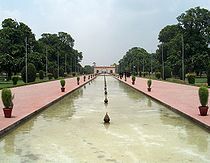 The Shalimar Gardens, comprising over four-hundred fountains, were built by the Mughal emperor.
The Shalimar Gardens, comprising over four-hundred fountains, were built by the Mughal emperor.
 The Taj Mahal is the most notable example of Islamic architecture in South Asia it was constructed according to the orders of the Mughal Emperor Shah Jahan.
The Taj Mahal is the most notable example of Islamic architecture in South Asia it was constructed according to the orders of the Mughal Emperor Shah Jahan.
Shah Jahan left behind a grand legacy of structures constructed during his reign. He was a patron of architecture. His most famous building was the Taj Mahal, now a wonder of the world, which he built out of love for Mumtaz Mahal. Its structure was drawn with great care and architects from all over the world were called for this purpose. The building took twenty years to complete and was constructed from white marble underlaid with brick.People believe that Shah Jahan cut off the worker's hands who built it so it can not be repeated. Upon his death, his son Aurangazeb had him interred in it next to Mumtaz Mahal. Among his other constructions are Delhi Fort also called the Red Fort or Lal Qila (Urdu) in Delhi, large sections of Agra Fort, the Jama Masjid (Grand Mosque), Delhi, the Wazir Khan Mosque, Lahore, Pakistan, the Moti Masjid (Pearl Mosque), Lahore, the Shalimar Gardens in Lahore, sections of the Lahore Fort, Lahore, the Jahangir mausoleum — his father's tomb, the construction of which was overseen by his stepmother Nur Jahan and the Shahjahan Mosque, Thatta, Pakistan. He also had the Peacock Throne, Takht e Taus, made to celebrate his rule.
A famous Seamless celestial globe was produced in 1659-1660 AD (1070 AH), by the Sindhi Astronomer Muhammad Salih Tahtawi of Thatta with Arabic and Persian inscriptions.
There is a crater named after Shah Jahan on the asteroid 433 Eros. Craters on Eros are named after famous fictional and real-life lovers.
Shah Jahan's Coins
European accounts of Shah Jahan's personal life
Numerous accounts of Shah Jahan's personal life were recounted by contemporary European writers.
Shah Jahan's family
Like all his ancestors, Shah Jahan's court included 8
wives, concubines, and dancing girls. Several European chroniclers noted this. Niccolao Manucci wrote that "it would seem as if the only thing Shahjahan cared for was the search for women to serve his pleasure" and "for this end he established a fair at his court. No one was allowed to enter except women of all ranks that is to say, great and small, rich and poor, but all beautiful".[25] When he was detained in the Agra Fort, Aurangzeb permitted him to retain "the whole of his female establishment, including the singing and dancing women."[26]
See also
- Agra
- Delhi
- Nur Jahan
- Lahore
- Mughal architecture
- Muhammad Saleh Kamboh
- Mumtaj Mahal
- Shah Jahan Mosque
- Shaikh Inayat Allah Kamboh
- Taj Mahal
Notes
- ^ Shah Jahan. Britannica Concise.
- ^ The Descendants of Theodora Comnena of Trebizond: Charlemagne to the Mughals
- ^ [Bierbier, M. L. (1998), "The Descendants of Theodora Comnena of Trebizond", The Genealogist 12 (1)]
- ^ Mahajan, Vidya Dhar (1970). Muslim Rule In India. p. 286.
- ^ Hebbar, Neria Harish (June 2002). "King of the World: Shah Jahan". History of Islam in India. Boloji Media Inc. http://www.boloji.com/history/013.htm. Retrieved 2007-07-23.
- ^ Discovermagazine.com blogs
- ^ a b c Asher, p.170
- ^ a b Koch, p.18
- ^ a b c Koch, P.19
- ^ Qazwini. fol. 233a translated by Begley and Desai (1984), p.14
- ^ Bloom, J. and Blair, S. (1994). "The Art and Architecture of Islam: 1250-1800". New Haven and London: Yale University Press
- ^ Encyclopedia of World Biography on Shah Jahan
- ^ Encyclopedia Britannica Online - Rebellion of Khurram
- ^ Munis Faruqui, Princes and Power in the Mughal Empire, 1569-1657(2002) p.272
- ^ Mountstuart Elphinstone, History of India (London, 1905), p. 106.
- ^ http://www.columbia.edu/itc/mealac/pritchett/00islamlinks/ikram/part2_16.html
- ^ http://www.youtube.com/watch?v=8jkaxv-WtAI
- ^ a b Asher, p.171
- ^ Hunter, p.307
- ^ Black Taj Mahal Myths
- ^ Black Taj Mahal Story
- ^ Black Taj Mahal Spirituality
- ^ Havell
- ^ Koch, p.101
- ^ Manucci, I, p.195
- ^ Bernier, p.166 and p. 21
References
 This article incorporates text from a publication now in the public domain: Chisholm, Hugh, ed (1911). Encyclopædia Britannica (11th ed.). Cambridge University Press.
This article incorporates text from a publication now in the public domain: Chisholm, Hugh, ed (1911). Encyclopædia Britannica (11th ed.). Cambridge University Press.- Asher, Catherine Ella Blanshard (2003) (Hardback). The New Cambridge History of India, Vol I:4 - Architecture of Mughal India (First published 1992, reprinted 2001,2003 ed.). Cambridge: Cambridge University Press. p. 368. ISBN 0-521-26728-5.
- Padshah Nama, a book written by Abdul Hamid Lahori
- Shah Jahan Nama/Amal-i-salih by Inayat Khan/Muhammad Saleh Kamboh
- Nushka i Dilkhusha by Bhimsen
- Bernier, Francois, Travels in the Mogal Empire (1656–68), revised by V.A. Smith, Archibald Constable, Oxford 1934.
- Tavernier, Jean Baptiste, Travels in India, trs. and ed. by V.Ball, 2 Vols. Macmillan, 1889, 1925.
- De Laet, Joannes, The Empire of the Great Mogol, trs. byHoyland and Banerjee, Bombay 1928.
- Peter Mundy. Travels of Peter Mundy in Asia, ed. R.C. Temple, Hakluyt Society, London 1914.
- Manucci, Niccolao, Storia do Mogor, Eng. trs. by W. Irvine, 4 vols. Hohn Murray, London 1906.
- Manrique, Travels of Frey Sebastian Manrique, trs. by Eckford Luard, 2 Vols. Hakluyt Society, London 1927.
- Lal, K.S. (1988). The Mughal Harem. New Delhi: Aditya Prakashan. ISBN 81-85179-03-4.
- Begley, W, The Symbolic Role of Calligraphy on Three Imperial Mosques of Shah Jahan, Kaladarsana, 1978, pp. 7 – 18
- Koch, Ebba (Hardback). The Complete Taj Mahal: And the Riverfront Gardens of Agra (First ed.). Thames & Hudson Ltd. pp. 288 pages. ISBN 0500342091.
- Hunter, William., The Imperial Gazetteer of India.Turbner & Co.: London 1886
- A Handbook to Arga and the Taj by E.B. Havell
External links
- Shah Jehan in Christian Art
- Shah Jahan's 353rd death anniversary observed at Taj Mahal at TwoCircles.net
- History of Islam in India at IndiaNest.com
- A Handbook to Agra and the Taj - Sikandra, Fatehpur-Sikri and the Neighbourhood by E. B. Havel (Project Gutenberg)
- Indian & Mughal History Discussions at History Forum
- 'The Man Of Marble' - Outlook India
- [1]
Shah JahanBorn: 5 January 1592 Died: 31 January 1666Regnal titles Preceded by
JehangirMughal Emperor
1627–1658Succeeded by
AurangzebCategories:- Taj Mahal
- Mughal emperors
- 1592 births
- 1666 deaths
- People from Agra
- Indian monarchs
- Agra
Wikimedia Foundation. 2010.


